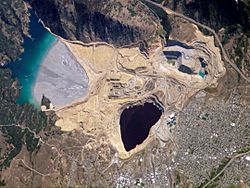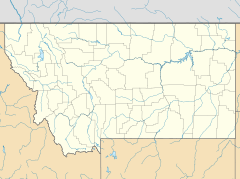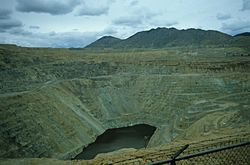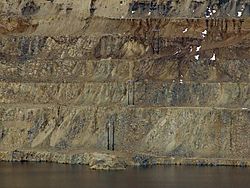Berkeley Pit facts for kids
Quick facts for kids Silver Bow Creek/Butte Area |
|
|---|---|
| Superfund site | |

Berkeley Pit (center) and Yankee Doodle Tailings Pond (upper left) with terraced levels/access roadways. The city of Butte is in the lower right corner.
|
|
| Geography | |
| City | Butte |
| County | Silver Bow County |
| State | Montana |
| Coordinates | 46°01′02.38″N 112°30′36.60″W / 46.0173278°N 112.5101667°W |
| Information | |
| CERCLIS ID | MTD980502777 |
| Contaminants | Arsenic, cadmium, copper, zinc, lead |
| Progress | |
| Proposed | 12/30/1982 |
| Listed | 09/08/1983 |
| List of Superfund sites | |
The Berkeley Pit is a huge former open pit copper mine located in Butte, Montana. It is about 1 mile (1.6 km) long and 0.5 miles (0.8 km) wide. The pit is very deep, about 1,780 feet (543 m).
Today, the pit is filled with about 900 feet (274 m) of water. This water is very acidic, like Coca-Cola or lemon juice. Because of this, the water contains many heavy metals and dangerous chemicals. These include copper, arsenic, cadmium, zinc, and sulfuric acid.
The mine opened in 1955. It was run by the Anaconda Copper Mining Company and later by the Atlantic Richfield Company (ARCO). The mine closed on Earth Day in 1982. When it closed, the water pumps were turned off. This allowed groundwater to slowly fill the pit. The water level rises about 1 foot (300 mm) each month.
The Berkeley Pit is now one of the largest Superfund sites. A Superfund site is a place with dangerous pollution that needs a big cleanup. The water in the pit causes more acid to form from the rocks. This acid then carries many dissolved metals. A special water treatment plant started working in October 2019 to clean this water.
Today, the Berkeley Pit is also a tourist spot. Visitors can pay a small fee to see it from a viewing platform. There is also a gift shop nearby.
Contents
History of the Mine
The Berkeley Pit got its name from an older underground mine nearby. This underground mine was on a large vein of minerals. Open-pit mining began in July 1955. This new method was much safer and cheaper than digging underground.
In its first year, the pit produced 17,000 tons of copper ore every day. Over time, about 1 billion tons of material were dug out of the Berkeley Pit. Copper was the main metal found. But other valuable metals like silver and gold were also mined.
During the 1970s, the mine needed to expand. The Anaconda Company bought homes, businesses, and schools in nearby communities. These areas included Meaderville, East Butte, and McQueen. Many buildings were moved or destroyed. The people living there were paid for their properties.
Pollution and Cleanup Efforts
The Berkeley Pit is part of a very large Superfund site. This site is called the Silver Bow Creek/Butte Area. The pit itself was added to the federal Superfund list in 1987. This means it is a major pollution site that needs a lot of cleanup work. It is one of 16 Superfund sites in Montana.
In 1995, a group of migrating geese landed in the pit's water. Sadly, all 342 geese died. Tests showed their insides were burned and sore. This was from being exposed to high levels of copper, cadmium, and arsenic.
Another sad event happened on November 28, 2016. Several thousand snow geese died after landing in the pit. They were trying to avoid a snowstorm. Officials quickly tried to scare other birds away. A report in 2017 confirmed the geese died from the pit's sulfuric acid and heavy metals.
To stop birds from landing, the pit now uses "Phoenix Wailers." These devices make sounds to scare birds away. Staff also use special firearms to scare birds during migration seasons. These methods help, but large groups of birds can still be a challenge.
A new water treatment plant began construction in 2018. This plant cleans the pit water before it can pollute nearby groundwater. The facility can treat 10 million gallons of water every day. It cost $19 million to build and was finished in August 2019. The first treated water was released into a local creek in October 2019.
Important Cleanup Dates
- 1994 – The EPA and Montana DEQ decide on a cleanup plan for the Butte Mine Flooding.
- 1996 – Montana Resources (MR) and ARCO divert water away from the pit. This helps slow down how fast the pit fills.
- 2002 – The EPA and MDEQ make an agreement with BP/ARCO and Montana Resources. This agreement helps pay for cleanup costs.
- 2003 – A new water treatment plant starts working. This plant helps slow the pit from filling even more.
Geography and Life in the Pit
The mine is located at an altitude of 4,698 feet (1,432 m) above sea level.
Geology of the Area
The Butte mining area has special rocks formed a long time ago. Mining for minerals started here in 1864. First, people dug for gold in placer deposits. Then, silver was found in veins. In 1888, copper was discovered. Open-pit mining began in 1955. Copper has always been the main metal mined here. Other metals like lead, zinc, manganese, silver, and gold were also found.
Life in the Water
Even though the water is very acidic and full of chemicals, some tiny living things have been found there. A type of protozoan called Euglena mutabilis lives in the pit. These tiny organisms have learned to survive in the harsh water.
Scientists are studying these organisms. They produce special compounds to help them survive. Some of these compounds are even being looked at for use against cancer cells. Also, some of these organisms can take in metals. This means they might help clean the water in the future.
Images for kids
-
Butte District Geologic map











